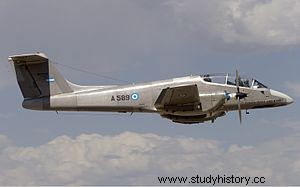
Type :anti-guerrilla plane.
Engines :two 762 kW (1022 hp) Turboméca Astazou XVIG turboprop engines.
Performance :maximum speed at 3,500 m altitude, 500 km/h
range in clean configuration with maximum fuel load at 5,000 m altitude, 3,050 km.
Weight :empty, 4,037 kg; maximum take-off, 6,800 kg.
Dimensions :
wingspan , 14.50 m;
length , 14.25 m;
height , 5.36 m;
wing area , 30.30 m2.
Armament :2 × 20 mm Hispano HS 804 cannons of 270 rounds each and 4 × 7.62 mm FN-Browning machine guns of 900 rounds each, all mounted in the fuselage; 3 pylons capable of receiving 1,620 kg of external loads, including one of 1,000 kg.
Inspired by the many American anti-guerrilla warfare aircraft of the early sixties, the Argentinian light attack aircraft FMA TA 58A Pucarà was started in
1966. If the first prototype took to the air on August 20, 1969, the first IA 58A production unit only left the ground on November 8, 1974, after a long phase of additional development. By 1983, one hundred units had already been sold, six of them to Uruguay. Powered by two Turboméca Astazou turboprops of French origin driving Hamilton Standard propellers, the Pucarà is equipped with relatively rudimentary avionics allowing it to operate only during the day, at low altitude. Argentinian planes are indeed devoid of radars - which did not prevent them from being extremely active during the Falklands war, during which the Pucarà were, with the M.B.399 of the navy, the only planes to operate from the 'archipelago. They were
employed on this occasion against ground targets, as well as against the helicopters embarked by the Royal Navy. Twenty-three were, however, destroyed or seized by the British. Two other versions, the IA 58B (featuring more sophisticated avionics and a nose enlarged to accommodate two DEFA 553 30mm cannons), and the IA 66 (powered by two Garrett TPE331 engines) took to the air respectively in 1979 and 1980.
